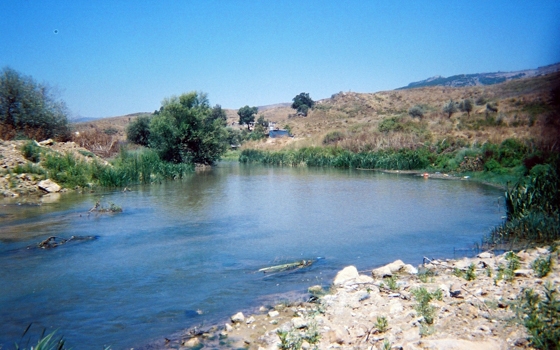Lebanese officials announced an ambitious seven-year plan that will cost hundreds of millions of dollars to clean up what they described as the “catastrophe” of pollution at the Litani River and Qaraoun Lake.
The $730 million proposal will expand sewage treatment networks, manage solid waste and pesticide pollution into the river, and help factories reduce the dumping of chemicals into the water.
It has been approved by the finance and public works committees in Parliament, and will be put to a vote when legislative sessions, which are held hostage by the vacuum in the presidency, resume. The proposal was unveiled at a roundtable in the Grand Serail.
The drafting of the law implementing this new road map was spearheaded by Bekaa Valley and south Lebanon MPs who have been hit hard by the pollution of the Litani, a key artery in the country whose water is used for irrigation and kept in storage for dry seasons.
“It transformed from a blessing to a problem,” said West Bekaa lawmaker Jamal Jarrah, who helped draft the law.
Jarrah warned that untreated waste, overuse of pesticides, garbage and pollution had contaminated most of Lebanon’s agricultural products and rendered fish in the Qaraoun Lake inedible.
Jarrah acknowledged the enormous cost of the road map, but said there would be dire consequences for all the Lebanese if it was not implemented, and asked international organizations to visit key points along the river’s path to witness what he described as a “tragedy” and “catastrophe” facing communities there.
The Litani provides roughly 160 million cubic meters of water for irrigation and power generation. Another 60 million cubic meters is used for storage every year in dry seasons.
Most of the pollution contaminating the Litani comes from solid waste and municipal waste water that is dumped into the river, agricultural pollution from pesticides washing into the water and chemical waste from industrial plants.
The pollution has rendered the water of the Qaraoun Lake unsuitable for drinking or aquatic life. A study commissioned by the European Union in 2012 estimates the economic cost of the pollution in the Upper Litani at about $230 million.
The new road map to clean the Litani was outlined by Manal Moussallem, an environmental adviser with the U.N. Development Fund and the Environment Ministry.
Out of the $733 million that will be earmarked for the proposal, 14 million will go to solid waste treatment, $2.6 million for agricultural pollution, $2.6 million for industrial pollution and $712 million for sewage treatment.
The Lebanese government has already secured $19 million from the European Union to expand its solid waste treatment facilities in the Bekaa, including a sorting and composting plant for garbage, a facility that generates biogas from waste and a sanitary landfill in Baalbek.
Similar plants are also planned for Zahle and Jebjennine.
Solid waste is a problem for municipalities in Lebanon, which do not usually separate and recycle waste.
The World Bank has also approved a $50 million loan that will expand sewage collection networks in Zahle, Anjar and other areas.
Some of the money will go to improving pest management in Lebanese farms, in order to help reduce the use of pesticides.
Untreated sewage dumped in rivers is a major cause of the Litani’s contamination, and can affect crops irrigated with water from the river.
Another $15 million World Bank loan will go toward technical assistance for factories to help them comply with environmental regulations that limit the disposal of industrial waste into the river.
Last week, The Daily Star reported the findings of two new studies that revealed high levels of heavy metals and contamination with dangerous bacteria in the Lower Litani River Basin and the Hasbani River, largely due to industrial waste and untreated sewage that is disposed in the water.
The Daily Star
7 June






















































